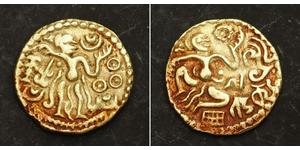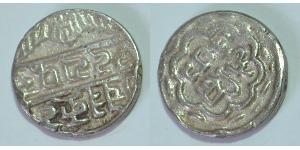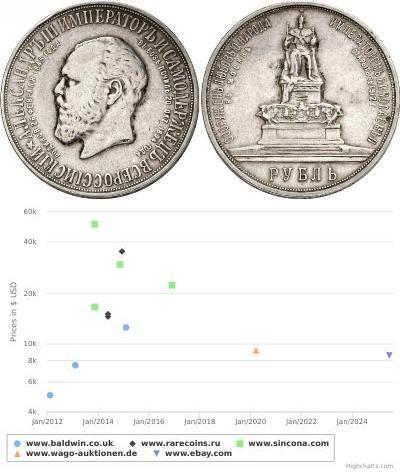(Vendida por $554.0)
Constans II Pogonatos (641-668 AD) Scarce Globular Gold Solidus Coin. Carthage mint!
Denomination: Solidus
Mint Place: Constantinople
Mint Period: 662/667 (officina A)
Reference: Friedberg 118, Sear 1037, DOC 116, MIB 64. R!
Condition: Ex-jewellery (welding marks on rim), otherwise VF.
Rulers: Constans II Pogonatus ("Constantine the Bearded") with Constantinus IV, Heraclius and Tiberius as co-rulers.
Diameter: 11mm
Weight: 4.28gm
Material: Gold!
Obverse: Crowned bust with long beard facing, globe cruciger in right hand.
Legend: D N CO – NSTNT
Reverse: Cross potent on four steps.
Legend: VICTO – RA SIB
Exergue: CONOB
Carthage is a suburb of Tunis, Tunisia that was the centre of the Carthaginian Empire in antiquity. The city has existed for nearly 3,000 years, developing from a Phoenician colony of the 1st millennium BC into the capital of an ancient empire.
The first civilization that developed within the city's sphere of influence is referred to as Punic (a form of the word "Phoenician") or Carthaginian. The city of Carthage is located on the eastern side of Lake Tunis across from the center of Tunis. According to Greek historians, Carthage was founded by Canaanite-speaking Phoenician colonists from Tyre (in modern Lebanon) under the leadership of Queen Elissa or Dido. It became a large and rich city and thus a major power in the Mediterranean. The resulting rivalry with Syracuse, Numidia, and Rome was accompanied by several wars with respective invasions of each other's homeland.
Hannibal's invasion of Italy in the Second Punic War culminated in the Carthaginian victory at Cannae and led to a serious threat to the continuation of Roman rule over Italy; however, Carthage emerged from the conflict weaker after Hannibal's defeat at the Battle of Zama in 202 BC. Following the Third Punic War, the city was destroyed by the Romans in 146 BC. However, the Romans refounded Carthage, which became the empire's fourth most important city and the second most important city in the Latin West. It later became the capital of the short-lived Vandal kingdom. It remained one of the most important Roman cities until the Muslim conquest when it was destroyed a second time in 698.
The ancient Greek philosopher Aristotle wrote extensively on Carthaginian politics, and he considered the city to have one of the best governing institutions in the world, along with those of the Greek states of Athens, Sparta and Crete.
Constans II (Greek: Κώνστας Β', Kōnstas II), also called Constantine the Bearded (Kōnstantinos Pogonatos), (November 7, 630 – September 15, 668) was Byzantine Emperor from 641 to 668. He also was the last emperor to become consul in 642, becoming the last Roman consul in history.
Constans is a diminutive nickname given to the Emperor, who had been baptized Herakleios and reigned officially as Constantine. The nickname established itself in Byzantine texts, and has become standard in modern historiography.
Constans was the son of Constantine III and Gregoria. Due to the rumours that Heraklonas and Martina had poisoned Constantine III he was named co-emperor in 641. Later that same year his uncle was deposed and Constans II was left as sole emperor.
Constans owed his throne to a popular reaction against his uncle and to the protection of the soldiers led by the general Valentinus. Although the precocious emperor addressed the senate with a speech blaming Heraklonas and Martina for eliminating his father, he reigned under a regency of senators led by Patriarch Paul II of Constantinople. In 644 Valentinus attempted to seize power for himself but failed.
Under Constans, the Byzantines completely withdrew from Egypt in 642, and Caliph Uthman launched numerous attacks on the islands of the Mediterranean Sea and Aegean Sea. A Byzantine fleet under the admiral Manuel occupied Alexandria again in 645, but after a Muslim victory the following year this had to be abandoned. The situation was complicated by the violent opposition to Monothelitism by the clergy in the west, and the related rebellion of the Exarch of Carthage, Gregory. The latter fell in battle against the army of Caliph Uthman and the region remained a vassal state under the Caliphate, until the civil war broke out and the imperial rule was again restored.
Constans attempted to steer a middle line in the church dispute between Orthodoxy and Monothelitism, by refusing to persecute either and prohibiting further discussion of the natures of Jesus Christ by decree in 648. Naturally, this live-and-let-live compromise satisfied few passionate participants in the dispute.
Meanwhile, the Caliphate advance continued unabated. In 647 they had entered into Armenia and Cappadocia, and sacked Caesarea Mazaca. In 648 the Arabs raided into Phrygia and in 649 launched their first maritime expedition against Crete. A major Arab offensive into Cilicia and Isauria in 650–651 forced the Emperor to enter into negotiations with Caliph Uthman's governor of Syria, Muawiyah. The truce that followed allowed a short respite, and made it possible for Constans to hold on to the western portions of Armenia.
In 654, however, Muawiyah renewed his raids by sea, and plundered Rhodes. Constans led a fleet to attack the Muslims at Phoinike (off Lycia) in 655 at the Battle of the Masts, but he was defeated: 500 Byzantine ships were destroyed in the battle, and the Emperor himself was almost killed. Before the battle, chronicler Theophanes the Confessor says, the Emperor dreamed of being at Thessalonika, this dream predicted his defeat against the Arabs because the word Thessalonika is similar to the sentence "thes allo niken", that means "gave victory to another (the enemy)".[3] Caliph Uthman was preparing to attack Constantinople, but did not carry out the plan when civil war between the future Sunni and Shi'a factions broke out among them in 656.
With the eastern frontier under less pressure, in 658 Constans defeated the Slavs in the Balkans, temporarily reasserting some notion of Byzantine rule over them. In 659 he campaigned far to the east, taking advantage of a rebellion against the Caliphate in Media. The same year he concluded peace with the Arabs.
Now Constans could turn to church matters once again. Pope Martin I had condemned both Monothelitism and Constans' attempt to halt debates over it (the Type of Constans) in the Lateran Council of 649. Now the Emperor ordered his Exarch of Ravenna to arrest the Pope. Exarch Olympius excused himself from this task, but his successor, Theodore I Calliopas, carried it out in 653. Pope Martin was brought to Constantinople and condemned as a criminal, ultimately being exiled to Cherson, where he died in 655.
Constans grew increasingly fearful that his younger brother, Theodosius, could oust him from the throne: he therefore obliged him first to take holy orders, and later had Theodosius killed in 660. Constans' sons Constantine, Heraclius, and Tiberius had been associated on the throne since the 650s. However, having attracted the hatred of citizens of Constantinople, Constans decided to leave the capital and to move to Syracuse in Sicily.
In Muslim Shia books there is story about the Emperor with the Hasan ibn Ali and Yazid I when he asked the two leaders Ali & Muawiyah to bring the best of their sons to do knowledge tests to them, it happened between 660-662.
From here, in 663, he launched an assault against the Lombard Duchy of Benevento, which then occupied most of Southern Italy. Taking advantage of the fact that Lombard king Grimoald I of Benevento was engaged against Frankish forces from Neustria, Constans II disembarked at Taranto and besieged Lucera and Benevento. However, the latter resisted and Constans withdrew to Naples. During the travel from Benevento to Naples, Constans II was defeated by Mitolas, Count of Capua, near Pugna. Constans ordered Saburrus, the commander of his army, to attack again the Lombards but he was defeated by the Beneventani at Forino, between Avellino and Salerno.
In 663 Constans visited Rome for 12 days—no emperor having set foot in Rome for two centuries—and was received with great honor by Pope Vitalian (657–672). Although on friendly terms with Vitalian, he stripped buildings, including the Pantheon, of their ornaments and bronze to be carried back to Constantinople, and in 666 declared the Pope of Rome to have no jurisdiction over the Archbishop of Ravenna, since that city was the seat of the exarch, his immediate representative.
His subsequent moves in Calabria and Sardinia were marked by further strippings and request of tributes that enraged his Italian subjects.
According to Warren Treadgold the first themes were created between 659 and 661, during the reign of Constans II.

50 Penny Reino Unido (1922-) Níquel/Cobr ...
grupo tiene 2 monedas / 1 precios
Add coin to this group
1/2 Scudo Ciudad del Vaticano Oro
grupo tiene 5 monedas / 5 precios
⇑
























